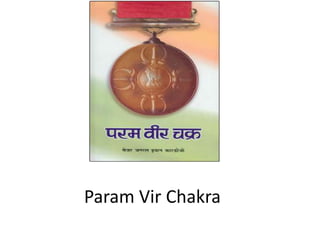Param Vir Chakra
- 2. Introduction • The Param Vir Chakra (PVC) is India's highest military decoration awarded for the highest degree of valour or self-sacrifice in the presence of the enemy. It can be, and often has been, awarded posthumously. • The PVC was established on 26 January 1950 (the date of India becoming a republic), by the President of India, with • effect from 15 August 1947 (the date of Indian independence).
- 3. • It can be awarded to officers or enlisted personnel from all branches of the Indian military. It is the second highest award of the government of India after Bharat Ratna • (amendment in the statute on 26 January 1980 resulted in this order of wearing). • It replaced the former British colonial Victoria Cross (VC)
- 4. Design • The medal was designed by Savitri Khanolkar (born Eva Yuonne Linda Maday-de-Maros to a Hungarian father and Russian mother) who was married to an Indian Army officer, Vikram Khanolkar. • This was done following a request from the first Indian Adjutant General, Major General Hira Lal Atal
- 5. • The medal is a circular bronze disc 1.375 inches (3.49 cm) in diameter. • The state emblem appears in the center, on a raised circle. Surrounding this, four replicas of Indra's Vajra (the all- powerful mythic weapon of the ancient Vedic King of Gods). • The decoration is suspended from a straight swivelling suspension bar. It is named on the edge. • On the rear, around a plain center, are two legends separated by lotus flowers. The words Param Vir Chakra are written in Hindi and English. • A purple ribbon, 32 millimetres (1.3 in) long, holds the Param Vir Chakra. The medal symbolizes Rishi Dadhichi, who had donated his bones to the Gods for making Vajra.
- 7. Statistics Established 26 January 1950 First awarded 3 November 1947 Last awarded 6 July 1999 Total awarded 21 Posthumous awards 14 Distinct recipients 21
- 8. Major Somnath Sharma(1947) • He was born on January 31 , 1 923, in Himachal Pradesh • Major Somnath Sharma laid down his life for the country on November 3, 1947 in Badgam, Kashmir in a brave e fight against Pakistan troops. • Major General Amarnath Sharma, his father, received India's first and highest wartime gallantry medal, Param Vir Chakra, on behlalf of his son
- 9. • Lance Naik Karam Singh Lance Naik Karam Singh was born on September 15, 1915, in Barnala, Punjab. • He had earned a Military Medal in World War II. After the Jammu & Kashmir operations in 1948 Karam Singh was honoured with the highest wartime gallantry medal, Param Vir Chakra, for his outstanding role in the battle of Tithwal. Lance Naik Karam Singh(1948)
- 12. Captain Vikram Batra(1999) • Captain Vikram Batra was awarded the Param Vir Chakra, India's highest medal for gallantry, posthumously. His father, Mr G.L. Batra, received the award from the President of India, on behalf of his brave son
- 13. Regiments • Of the 21 awardees, 20 are from the Indian Army and one from the Indian Air Force. Sikh Regiment have received the most number of Param Vir Chakras














